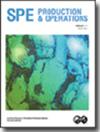螺杆泵流场数值模拟及性能分析
IF 1.3
4区 工程技术
Q2 ENGINEERING, PETROLEUM
引用次数: 1
摘要
螺杆泵是油气混合输送中必不可少的增压设备。PCP运行中相关参数的变化直接影响到泵的工作性能和使用寿命。本研究在计算流体力学(CFD)的基础上,应用动态网格技术,建立了长庆油田后南作区cq11 -2.4 4j PCP的三维流场数值计算模型。考察了油粘度、泵转速、泵差压、油空隙率等操作参数对PCP流场压力和速度分布的影响。分析中使用了油气两相混合物输送过程中的各种性能参数,包括体积流量、滑移、轴功率、体积效率和系统效率。结果表明:在不同工况下,PCP泵腔内的压力和速度分布较为均匀,而定子和转子密封线及泵腔内邻近区域的压力和速度变化较大;提高油的粘度和转子转速可以有效改善PCP的流动特性,但过高的泵转速会导致系统效率下降。增大压差和油的空隙率会导致PCP的体积流量和效率降低。考虑PCP性能参数的变化规律,PCP各运行参数的最佳区间为:油粘度为50 ~ 100 mPa·s,泵转速为200 ~ 300转/分,压差为0.2 ~ 0.3 mPa,油的空隙率不大于50%。本研究可为现场PCP工作条件的优化提供技术支持。本文章由计算机程序翻译,如有差异,请以英文原文为准。
Flow Field Numerical Simulation and Performance Analysis of Progressing Cavity Pump
Progressing cavity pump (PCP) is the essential booster equipment in oil–gas mixing delivery. Changes in relevant parameters in PCP operations directly affect the working performance and service life of the pump. On the basis of computational fluid dynamics (CFD) in this study, we apply dynamic grid technology to establish a 3D flow field numerical calculation model for the CQ11-2.4J PCP, which is used in the field of the Hounan Operation Area in Changqing oil field, China. The effects of several operating parameters, such as oil viscosity, pump rotation speed, differential pump pressure, and void fraction of oil, on the pressure and the velocity distribution of the PCP flow field are examined. Various performance parameters in the transport of the oil–gas two-phase mixture are used in the analysis, including volumetric flow rate, slippage, shaft power, volumetric efficiency, and system efficiency. The results show that the pressure and speed distribution in the pump chamber of the PCP is relatively homogenous under different working conditions, whereas the pressure and speed exhibited sharp changes at the stator and rotor sealing line and adjacent areas in the pump chamber. Increasing the viscosity of the oil and the speed of the rotor can effectively improve the flow characteristics of the PCP, but extremely high pump rotation speed would cause a decline in system efficiency. Increasing the differential pressure and the void fraction of oil would result in a decrease in the volumetric flow rate and efficiency of the PCP. Considering the variation law of the PCP's performance parameters, the optimal interval for each operating parameter of the PCP is as follows: Oil viscosity at 50–100 mPa·s, pump rotation speed at 200–300 rev/min, differential pressure at 0.2–0.3 MPa, and the void fraction of oil not more than 50%. This research can provide technical support for the optimization of the working conditions of the PCP on site.
求助全文
通过发布文献求助,成功后即可免费获取论文全文。
去求助
来源期刊

Spe Production & Operations
工程技术-工程:石油
CiteScore
3.70
自引率
8.30%
发文量
54
审稿时长
3 months
期刊介绍:
SPE Production & Operations includes papers on production operations, artificial lift, downhole equipment, formation damage control, multiphase flow, workovers, stimulation, facility design and operations, water treatment, project management, construction methods and equipment, and related PFC systems and emerging technologies.
 求助内容:
求助内容: 应助结果提醒方式:
应助结果提醒方式:


